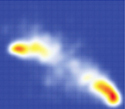 An international team studying the motion of both bacteria and similar-sized artificial catalytic nanomotors has found that they transfer momentum to their surroundings in a similar way, despite their very different propulsion mechanisms. The corkscrew motion of a bacterial flagellum causes bacteria to be attracted to surfaces, which is important for colonization of surfaces, biofilm formation and other emergent collective behavior relevant both to human health and the environment. The swarming behavior of collections of artificial swimmers – gold/platinum nanorods propelled by chemical reactions – suggests that similar physics governs both behaviors. Detailed analysis of the motion shows that it fits a simple hydrodynamic model despite the complexity of bacterial motion. A statistical analysis of bacterial motion reveals two populations – of active and random swimmers – whose behavior near surfaces closely matches that of artificial catalytically powered swimmers that were invented by MRSEC researchers.
An international team studying the motion of both bacteria and similar-sized artificial catalytic nanomotors has found that they transfer momentum to their surroundings in a similar way, despite their very different propulsion mechanisms. The corkscrew motion of a bacterial flagellum causes bacteria to be attracted to surfaces, which is important for colonization of surfaces, biofilm formation and other emergent collective behavior relevant both to human health and the environment. The swarming behavior of collections of artificial swimmers – gold/platinum nanorods propelled by chemical reactions – suggests that similar physics governs both behaviors. Detailed analysis of the motion shows that it fits a simple hydrodynamic model despite the complexity of bacterial motion. A statistical analysis of bacterial motion reveals two populations – of active and random swimmers – whose behavior near surfaces closely matches that of artificial catalytically powered swimmers that were invented by MRSEC researchers.
DMR-0820404